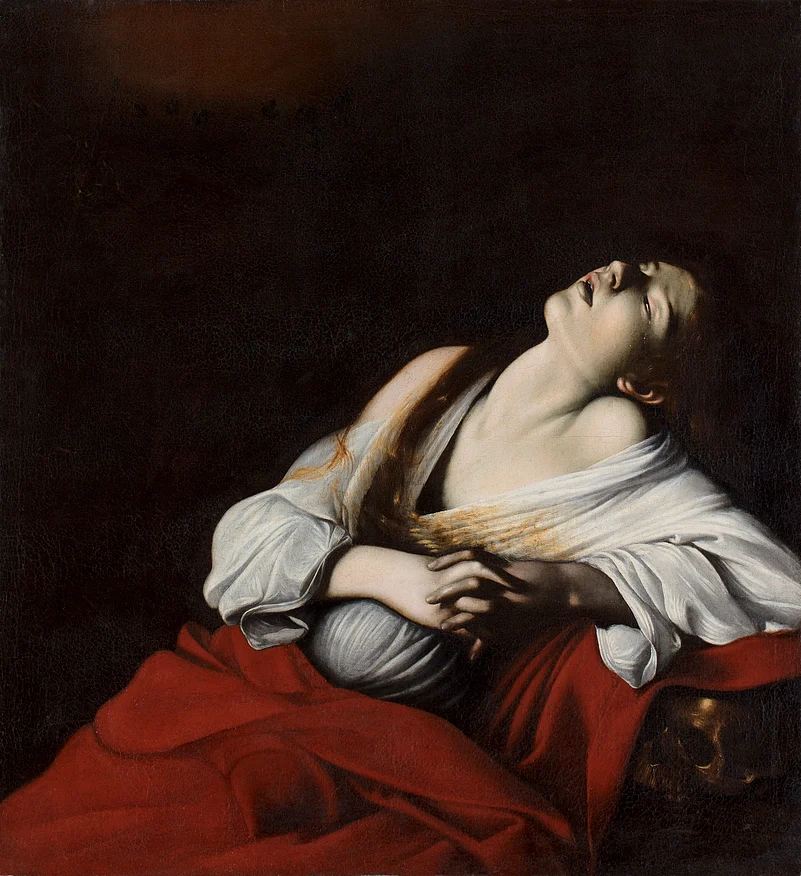A woman, draped in a loose white robe, leans back, eyes almost closed, mouth slightly parted, a single teardrop escapes her eye. Mary Magdalene in Ecstasy—a rare, once-lost canvas by the 17th-century Italian Baroque master Caravaggio—was on view for the first time in India.
Michelangelo Merisi da Caravaggio, born in Milan in 1571, was a disruptive force in European art. Rejecting the polished elegance of late Renaissance mannerism, his figures—biblical, mythological, or otherwise—were drawn from the street: common people with dirty fingernails, tensed muscles, and unidealised skin. His use of chiaroscuro—the violent interplay of darkness and light—brought Baroque art라이브 바카라 visceral theatricality to his canvas. As critics have long noted, Caravaggio라이브 바카라 work is intensely emotional, fluid, and turbulent.
His life mirrored his work. In 1606, after killing a man in a tavern brawl, Caravaggio fled Rome under threat of execution. It was during this exile, cut off from patrons and estranged from the city, that he painted Mary Magdalene in Ecstasy. Unlike earlier depictions that showed the saint ascending amidst angelic choirs, Caravaggio라이브 바카라 Magdalene sits alone in shadow, her face tilted upwards in an ambiguous rapture. Her isolation mirrors the artist라이브 바카라 own.
On 12 April 2025, the painting made its way to New Delhi, where it was jointly unveiled by the Kiran Nadar Museum of Art (KNMA) and the Italian Embassy Cultural Centre(IECC). The timing—coinciding with a state visit by Italy라이브 바카라 Deputy Prime Minister and Foreign Minister Antonio Tajani—underscored a deeper diplomatic subtext: the symbolic use of culture as soft power in strengthening bilateral ties between Rome and New Delhi.
Tajani opened the preview by emphasising art라이브 바카라 power to transcend borders and foster mutual understanding. “In sharing this masterpiece,” he said, “we are strengthening the bonds between our nations.” Roobina Karode, KNMA라이브 바카라 director and chief curator, described the moment as “a rare opportunity for Indian audiences to engage directly with Caravaggio라이브 바카라 vision.” Museum founder Kiran Nadar admitted she was moved to tears. “The expression on her face, the intensity of emotion—I felt it through the canvas,” she said.
The painting is striking and emotive. But it also invites a pause: what does it mean to present the grandeur of European art history in contemporary India, still negotiating the aftershocks of its colonial past? Can such an exchange be disentangled from the global hierarchies that shape which artworks are circulated, and which remain peripheral?
None of these questions undermine the poignancy of the moment—the power of standing before a Caravaggio in India is undeniable. But it does invite a more layered reading. Art, like diplomacy, rarely moves without consequence. And in this case, the masterpiece from Rome tells not just a story of emotion and light, but also one of power, privilege, and the continuing challenge of whose stories get to be told—and revered—on the world stage.
While Caravaggio라이브 바카라 work was at the centre of dialogue, it was not the only piece on view at the embassy. Opposite the Magdalene hung How Can You Sleep Tonight (1937) by Gulammohammed Sheikh, a founding member of the artist collective Group 1890. Sheikh is no stranger to themes of estrangement, displacement and turbulence, known for works like Riot (1973) and Speechless City (1975), inspired in the wake of the 1975 Emergency, his work engages directly with the psychic toll of political rupture. His style—narrative figuration infused with myth, memory, and ideology has long sought to make sense of both collective trauma and isolation.
Karode notes that Sheikh라이브 바카라 generation of Indian modernists viewed oil painting not merely as a technique but as a dialogue with European art. “Sheikh even got his start in Italy, there라이브 바카라 a kind of return happening here.” She said.
That idea of return took another form just outside the exhibition room. Mounted on the back wall where Tajani had spoken was Claire Fontaine라이브 바카라 neon installation Foreigners Everywhere / Stranieri Ovunque (2004–2024). In glowing orange multilingual text, the phrase lit up the space. “Wherever you go, you will always encounter foreigners—and at the same time, you are always, in some way, a foreigner yourself,” said Andrea Anastasio, director of the IECC.
Originally conceived in Paris, the Italian-British duo라이브 바카라 work has travelled across cities and contexts. Its Delhi iteration—unveiled during India Art Fair 2025— reflected themes of queerness, exile, and outsiderdom.
In the Indian context, however, this piece raises questions about the nature of cultural exchange, where race, caste and class all impact the distinctions between insiders and outsiders. The phrase stranieri ovunque—foreigners everywhere—flashes in the midst of a diplomatic gesture that, in many ways, upholds old hierarchies that privilege European art.
Caravaggio라이브 바카라 Magdalene, Sheikh라이브 바카라 politically charged dreamscape, and Fontaine라이브 바카라 glowing provocation form a triptych of estrangement and belonging. They gesture toward exile, mystery, and the effort to carry one's visual language across new terrain. They offer a dialogue across space, time, and cultures. But they also carry a shared reflection: how do we navigate the complex terrain of cultural exchange, where power, privilege, and legacy often shape the conversation?
The Magdalene does not offer answers. She remains suspended in grief, pleasure, or perhaps both. What endures is not clarity, but resonance: the persistence of images that move across borders, finding new meanings in unfamiliar rooms.
( Mary Magdalene in Ecstasy will be on display at KNMA Saket from 18 April to 18 May. Sheikh라이브 바카라 How Can You Sleep Tonight has been on view since 6 February and runs through 30 June)















